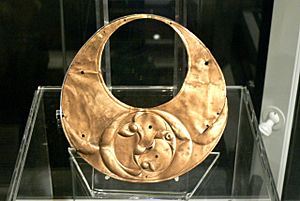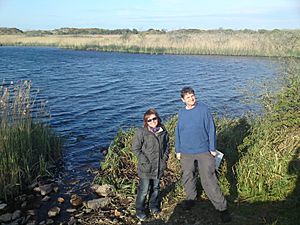Llyn Cerrig Bach facts for kids
Llyn Cerrig Bach is a small lake in Anglesey, Wales. It's found between the towns of Rhosneigr and Valley. Even though it's a small lake, it's very famous.
In 1942, over 150 ancient metal objects were found here. These items are from the Iron Age, a time long ago. People believe they were placed in the lake as special gifts, called votive offerings. These discoveries are super important. They show amazing La Tène style metalwork. It's one of the best collections found in the British Isles, especially in Wales.
Contents
Discovering Ancient Treasures

The amazing discovery at Llyn Cerrig Bach happened in 1942. William Owen Roberts, who worked at RAF Valley, found the items. He was clearing ground to make a longer runway for planes. This involved spreading peat (a type of soil) over sandy areas. The ancient objects were found while digging peat from a bog near the lake.
The very first item found was a long iron chain. It was used to hold several captives together. This chain got caught in a machine used for digging. At first, no one knew how old it was. It was even used to pull trucks out of the mud! The chain is over 3 meters long. It has five neck-rings and weighs about 6.66 kilograms.
The Mystery of the Chain
A historian named Cyril Fox studied the chain. He thought it was proof of Druids. Druids were important religious leaders in ancient Celtic societies. Fox believed the chain was used to transport people for special ceremonies. He based this idea on old writings that described Druids.
What Was Found?
After the chain was identified, people searched the area more carefully. They found many more objects. Most were made of iron, but some were bronze or copper. In total, 181 artifacts were recovered.
The National Museum of Wales describes the finds. They include:
- Seven swords
- Six spearheads
- Pieces of a shield
- Part of a bronze trumpet
- Another gang chain
- Pieces of iron wagon wheels
- Horse riding gear
- Blacksmith's tools
- Parts of two large cooking pots (cauldrons)
- Iron bars used for trading
- Animal bones
Gifts to the Gods
Many of these items were broken on purpose. Experts believe they were placed in the lake as votive offerings. This means they were gifts to gods or spirits. People in ancient times often gave valuable items to lakes or rivers. They hoped to get good luck or protection in return.
Some items were made right there in Anglesey. A few came from Ireland. But many objects came from southern England. This suggests that Llyn Cerrig Bach was a very famous holy place. Its fame might have spread far beyond Wales. It's also possible these items were traded. Or maybe they were treasures taken during battles by local tribes. There is no sign of Roman influence on any of the objects.
A Long History of Offerings
At first, people thought all the objects were put in the lake at the same time. But new studies show something different. The items were likely placed in the lake over a long period. This happened from about 300 BC to 100 AD. So, it was a special place for offerings for many years.
Most of the items found at Llyn Cerrig Bach are now in the National Museum of Wales in Cardiff. This museum has almost all the objects. However, some have been on loan to the Oriel Ynys Môn museum in Anglesey.



